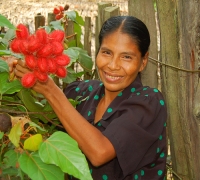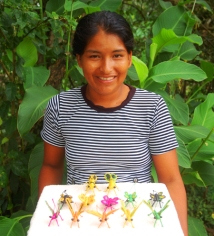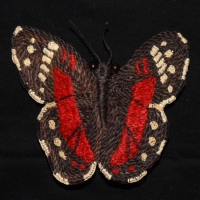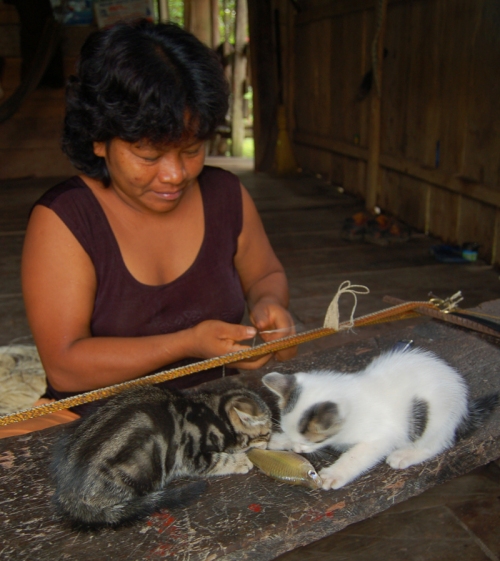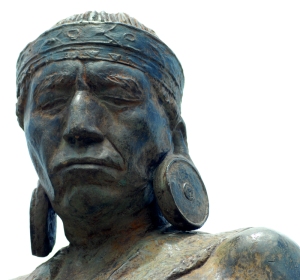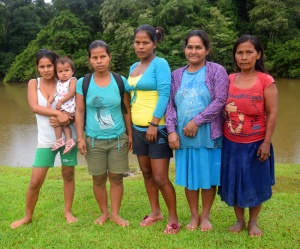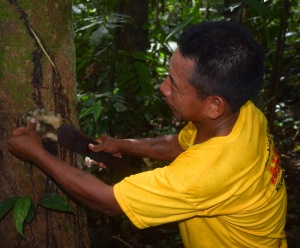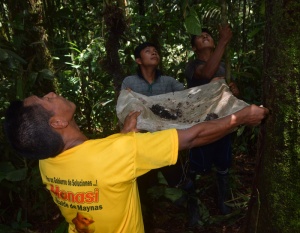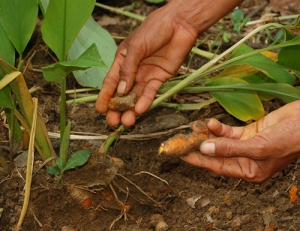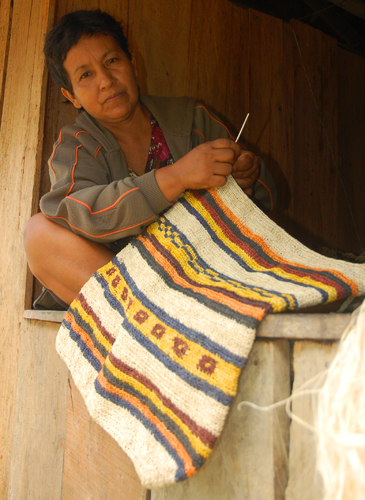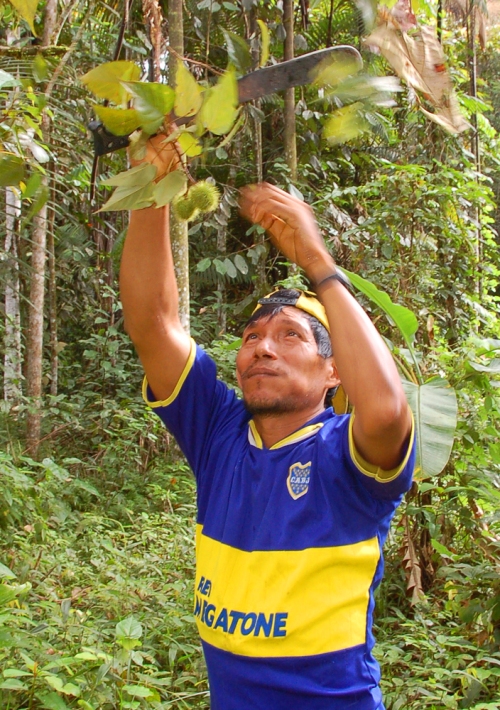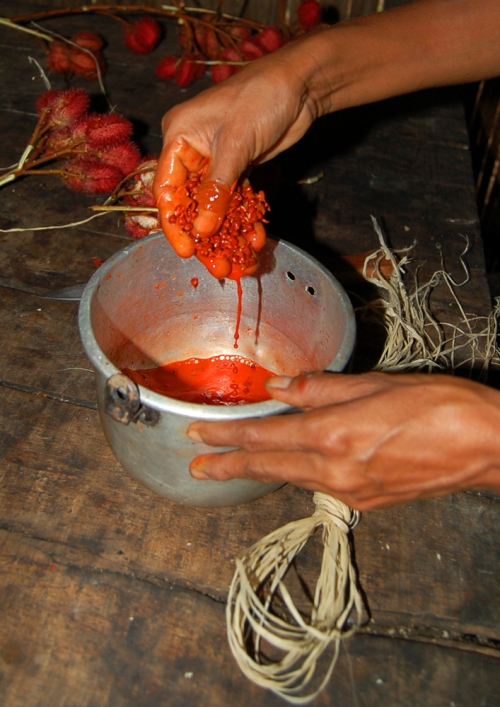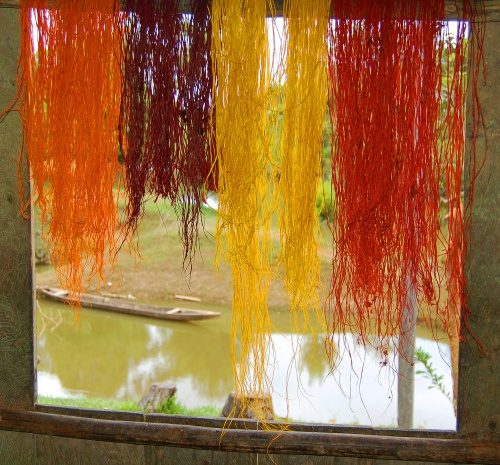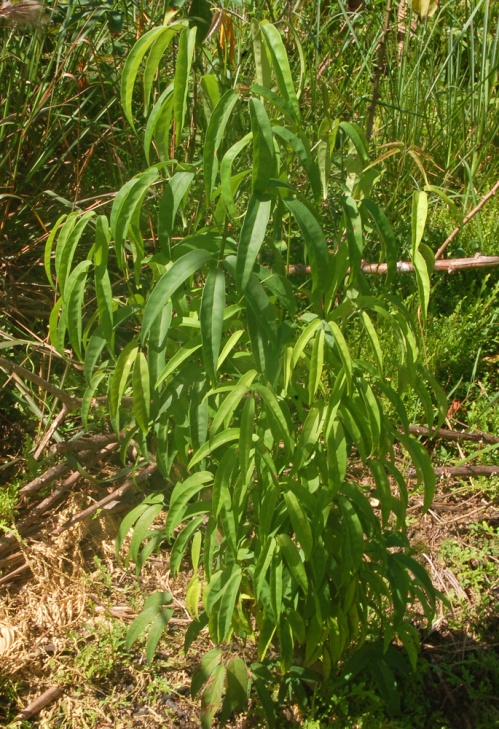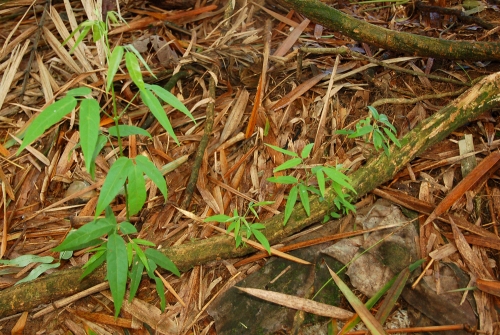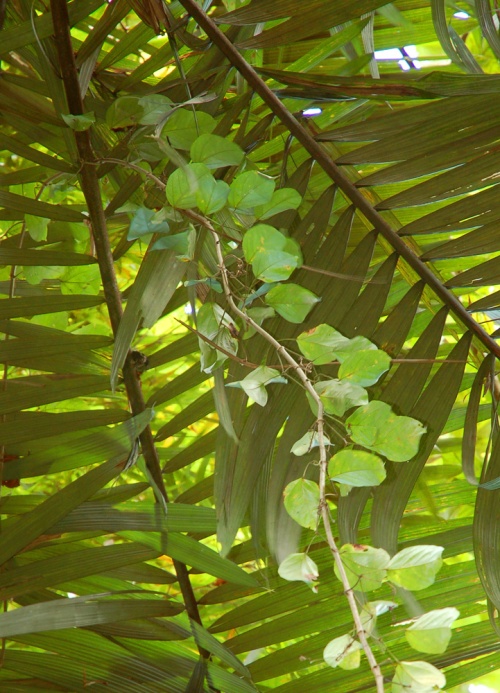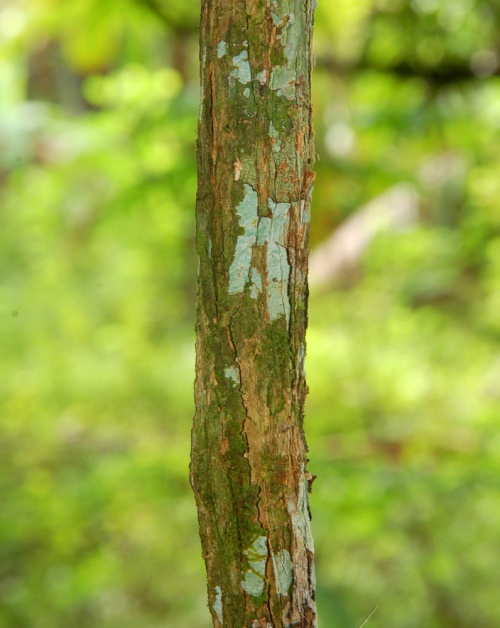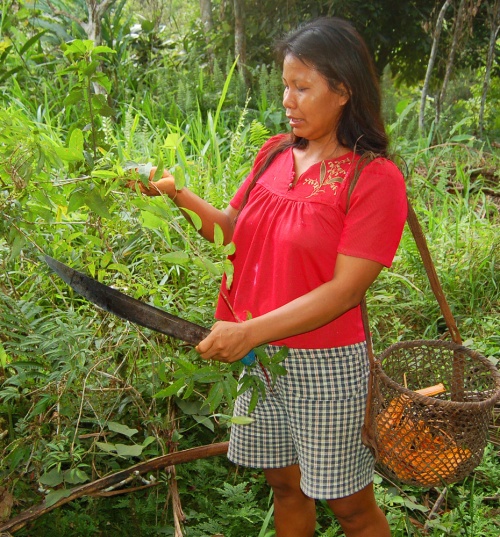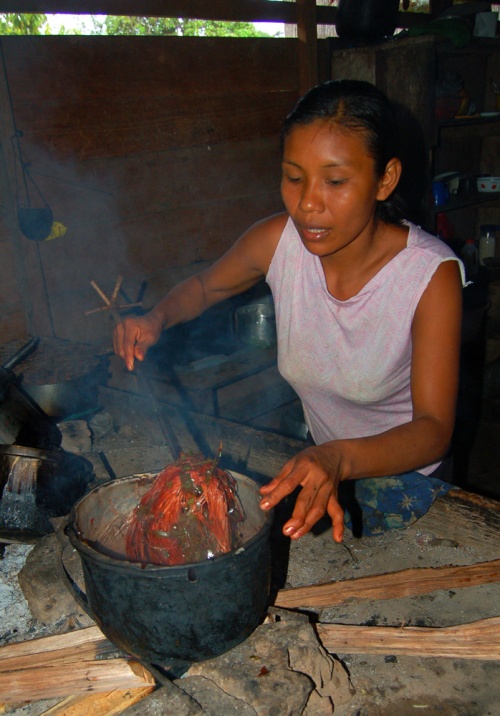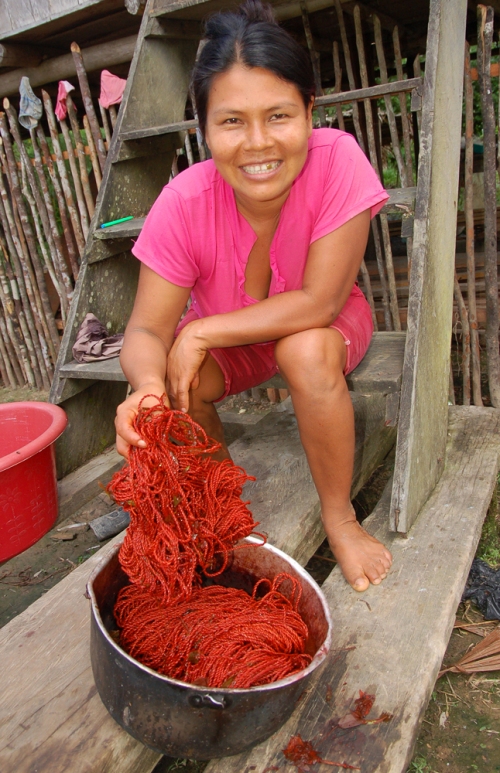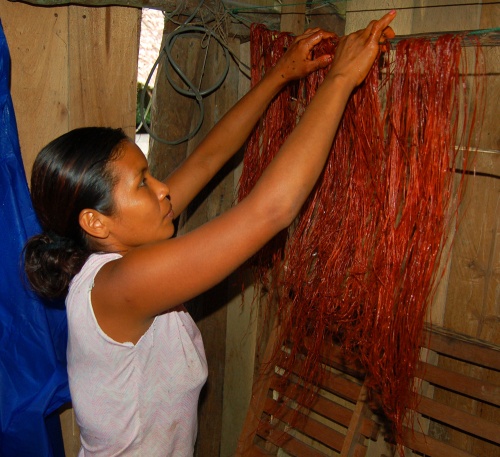
Ampiyacu skill-sharing workshop. Photo by Campbell Plowden/CACE
One of CACE’s most successful programs working with artisans in the Ampiyacu River region has been to organize skill-sharing workshops where five or six veteran artisans show other artisans how to make a new special kind of handicraft. While these workshops have steadily increased the number of native artisans who know how to make CACE’s best-selling models of hot pads, belts, guitar straps, and Christmas tree ornaments, we and our partners recognize that they also needed to become better organized to fully use this growing capacity to make and sell more high-quality crafts.
We did done some leadership training workshops with the Field Museum in 2014, but progress in this area has been slow. I had told the Ampiyacu native artisans about several groups of campesino artisans along the Tahuayo River that had successfully formed associations and a community enterprise to improve their craft sales, and they seemed enthusiastic about meeting them to learn from their experiences.

Chino artisan Sartia with chambira basket. Photo by Campbell Plowden/CACE
While CACE has focused a lot of resources organizing workshops and other activities in the Ampiyacu, our relationship with the Tahuayo communities has been much simpler. I have visited the village of Chino once or twice a year since 2008 to buy the beautiful chambira baskets they make primarily to sell to visitors from a nearby tourist lodge operated by Amazonia Expeditions (AE). We have also worked with them to develop a colorful line of woven frog Christmas tree ornaments.

Exiles with new bathroom for Chino school. Photo by Campbell Plowden/CACE
As CACE has sold products made by the Chino artisans, we have regularly returned part of our profits to support local development needs. Unlike the Ampiyacu where discussions about the use of this social rebate have often been contentious, Chino village meetings have openly discussed all ideas presented, and quickly and amiably reached consensus about the best way to use the funds available. These projects have included buying new desks and building a new bathroom for the school, buying medicines for the village pharmacy, and providing food for work parties to care for chambira palms used to make woven crafts. When I asked Estelita, the president of the Chino artisan association whether I could bring along a few guests from the Ampiyacu on my next visit, she readily agreed.
Our two Ampiyacu artisans were Liz C., president of FECONA – the federation that represents the 15 native communities in the Ampiyacu watershed and Segundina, a savvy artisan chosen by 20 Bora artisans from Brillo Nuevo to represent them during this artisan exchange trip. We left Iquitos early on a Saturday morning on a speed boat belonging to the Rainforest Conservation Fund (RCF) – an NGO partner that has been working to improve forest and human health in the Tahuayo region for many years. Our drivers were RCF staffers Gerardo and Exiles who coordinate RCF community programs to reforest depleted populations of aguaje palm trees and train people to climb the trees with harnesses to collect their popular fruits rather than cut them down.
We bought some extra gas and water in the town of Tamshiyacu and passed the small lancha that takes 10 to 12 hours (instead of our four) to ferry local residents, bags of charcoal, sacks of aguaje and camu camu fruits and crates of fish from Tahuayo villages to market in Iquitos. We briefly stopped once more at the village of Buena Vista where fellow American Matt (a student working with RCF) and I checked in with the police manning the official entry point to the Tamshiyacu-Tahuayo Regional Conservation Area. We arrived in Chino in the early afternoon and were distressed to find that our host Estelita was laying sick in her hammock barely able to speak. The other artisans assured us, however, that we were welcome.

Campbell inspecting chambira baskets in Chino. Photo by Matt VanderMolen/CACE
After getting settled in the guest house formerly operated by RCF two minutes upriver, we returned to Chino to inspect the group of baskets that the Chino artisans had made to fill the CACE order. In the past I had bought all of my baskets there at a “feria” – a fair where every artisan in the cooperative would place all of the crafts she had available for sale on a table in front of her. This is the way that they also sell their products to tourists visiting from the AE lodge. I had bought over 400 baskets with unique designs this way, but I had found that the styles and quality of baskets had changed a lot from visit to visit over the past eight years. Sometimes for better; sometimes for worse. In order to develop a reliable supply of consistent quality baskets, I had sent photos of 32 models of baskets that we have sold asking the artisans to make one to three more of these specific designs.
The artisans had readily complied with our request to make more medium and small baskets since our customers had continued to admire but had been buying fewer of the more expensive large ones. I had also asked the artisans to make the baskets using the same colors as the models showed in the photos without using the seeds they used in the past to use to adorn the baskets since they might harbor insect pests. The seeds of “ojo de vaca” (cow’s eye) had a large deep brown center with a black rim. Huayruru seeds were naturally orange with a black patch in one corner of their oblong shape. Rosario seeds were a medium-sized grey pearl, and achira seeds were small black spheres. These seeds were readily available, cheap, and had distinct shapes, sizes and colors that provided beautiful accents to the woven chambira baskets. As I began to inspect the new baskets, I immediately spotted a big problem. Finding good substitutes for the seeds had proven more challenging than I thought.

Chambira basket with ojo de vaca, huayruru and rosario seeds. Photo by Campbell Plowden/CACE

Chambira basket with wooden beads. Photo by Campbell Plowden/CACE
Some artisans in the Tahuayo have gotten used to using wooden and other types of beads to finish their baskets for a separate export channel, so I didn’t think it would be a problem to do the same for our order. The Chino artisans, however, had just made due with whatever beads they had on hand to complete the CACE order in three weeks. I learned that these beads were not cheap and were difficult or impossible to buy in Iquitos. Some of the beads the artisans used were beautiful matches; others led to horrible clashes of colors and poor fits in open spaces.
I was still feeling weak and sick from my second trip to the Ampiyacu so I welcomed Segundina’s help to figure out how to handle this challenge. In this situation, some buyers simply say “this order is rejected because these products don’t meet our specifications.” We have worked hard, however, to establish trust in our relationships with our artisan partners. We acknowledge that while their job is to make quality crafts; CACE needs to recognize their reality which sometimes means admitting that we have asked them to do something that just wasn’t possible. We all need to be flexible and figure out the best solution available.

Segundina giving pointers to Pilar about basket color and finish. Photo by Campbell Plowden/CACE
In this case, I was fortunately able to offer some useful resources because I had stopped in Lima on my first day in Peru. After an exhaustive search of a market area focused on craft-related products, I had found one shop that sold a wide variety of painted wooden beads and huassai seeds (not a kind that hosts any insects). They were out of several colors that I had wanted, but I had at least been able to bring a good assortment of medium-sized colored beads to Chino.
Segundina and I inspected all 70 baskets and placed them into one of three piles: acceptable, acceptable if the beads were changed, and not acceptable if the chambira weaving or color was too poor to fix. Segundina asked Romelia, “Do you have any more of these large tagua beads? They would nicely accent the orange ring in this basket.” She asked Rosa, “Could you replace these pink beads with purple ones in these middle rows – they would go really well with the violet center of the basket.” She patiently explained to Pilar, “Your weaving is good, but the intensity of the color needs to be a lot stronger.” What amazed me and Segundina was that while she had come to Chino as an outsider to observe and learn, the Chino artisans readily recognized her as a fellow artisan with a keen eye and welcomed her suggestions for ways they could improve their work.

Flooded “chacra” (farm field) at Chino. Photo by Campbell Plowden/CACE
The Ampiyacu artisans soon got to see and hear how the Chino artisans have persisted through many tough times, particularly the ebb and flow of visiting tourists and river levels. The flux in tourism produces alternating seasons with good income and almost no income from craft sales. Extreme floods in these villages have sometimes killed most of their chambira palm trees and farm crops. Some artisans have left the village so their families could seek more income or better education for their children in the city. The Chino artisans have survived simply because they have learned to trust each other, work together, and have the support of their whole community.

Romelia sewing in new beads to basket. Photo by Campbell Plowden/CACE
Estelita rallied from her hammock to share the history of the Chino artisans with their new friends from the Ampiyacu. “Long ago we had a few women who had learned how to weave chambira in other places, but Dolly (co-owner of the AE lodge) inspired us to learn how to make baskets the tourists would like and to get organized. We worked with the name “Huacamayo (macaw) Association” for a long-time, but when we decided to formally register our group, this name was taken, so we are now officially called, “Manos Amazonicos” (Amazon Hands). In the beginning, some of our husbands seemed threatened by the idea of women working together and potentially making more money than them. Fortunately, this has now completely changed. The men in Chino recognize that selling crafts generates a very important source of income for the whole village. Everyone also appreciates that selling crafts to CACE has helped our school and other things in our community.”
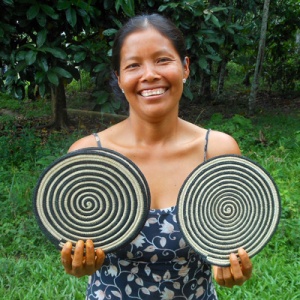
Milda from Puca Urquillo with woven hot pads. Photo by Campbell Plowden/CACE
Later in the evening, I showed the Chino artisans pictures of the diverse crafts that the Ampiyacu artisans have been making with us. Norma remarked, “Wow, those placemats are beautiful! I bet making a belt so straight is not easy.” Liz and Segundina nodded in agreement. Madita said, “I’ve made a few bottle carriers before, but they haven’t sold so well. Now I think I know how to make them better. I’m sure the tourists who visit here will love them!” After closely watching the Chino artisans make baskets all day, Segundina said, “When I go back to Brillo Nuevo, I’m going to try making a basket adapting the base of a hot pad. I don’t need to copy the patterns here – I’ve got my own ideas.”
I had been reluctant to share images of one community’s unique crafts with artisans from another region for a long time because I had thought it was important to respect each community’s creativity. I learned during this trip that while my desire to respect each group’s intellectual output was well-intentioned, trying to keep these groups a part was restricting their collective creative potential.
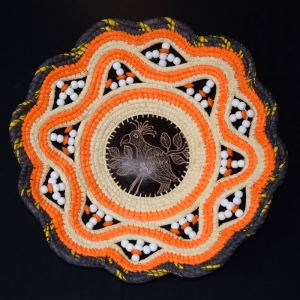
Chambira basket with etched bird calabash pod center. Photo by Campbell Plowden/CACE
This visit not only sparked ideas for ways that each group of artisans might improve their respective crafts but generated a proposal for a collaborative handicraft project. In the past, a few Chino artisans have etched wildlife figures onto calabash pods that have been woven into the center of baskets. They were great when done well, but many baskets which were beautifully woven seemed spoiled when their centers were adorned with mediocre carvings.
While committed weavers could improve their carving, they are unlikely to get as much practice refining this craft as the handful of Ampiyacu artisans who are now producing hundreds of gorgeous carved calabash pod ornaments with a range of Amazon birds, mammals, frogs and fish for CACE. We will now ask these carvers to see if they would like to produce four to five inch wide carved pieces that Chino artisans can sew into some of their chambira baskets.

Estelita measuring chambira basket length. Photo by Campbell Plowden/CACE
The next day, the Chino artisans stacked up their finished baskets on a table where Estelita measured each one to make sure its size and price were correctly recorded on the tag and in her ledger. She told one artisan, “this basket is half a centimeter less than its proper length; you can’t get full price for it. Please pay better attention to the standard sizes.” Liz and Segundina were stunned to see how the Chino artisans had direct responsibility for quality control and agreed to consistent pricing among their members. Segundina said, “My fellow artisans often criticize each other, but they find it hard to ask for and accept suggestions for ways to make their crafts better. We have to figure out how to encourage and trust each other to improve our quality and hold each other accountable; this will help all of us.” Liz added, “When tourists come to my village, they often shop from house to house because some artisans try to undercut their prices to make a sale. We have to get on the same page so everyone gets a fair price for making the best crafts.”

Campbell with artisans in front of Chino “Escuela de artesanas.” Photo by Matt VanderMolen/CACE
One highlight of the visit was visiting the new “Escuela de artesanas” – the artisan school under construction in Chino. After major floods destroyed the last simple building the artisans used to sell their crafts to tourists, the artisans decided they needed a larger and stronger building where they could gather to dye their chambira with roots, fruits, leaves and bark and weave their crafts under one roof. They could then demonstrate these traditional techniques to visiting tourists – giving them a more personal experience and incentive to buy the crafts offered for sale.
The ability to work together will also help the Chino artisans improve the consistency of their work by using the same batch of colored chambira to make multiple baskets with the same design. The structure built with sturdy wooden beams, cement and rebar was progressing, but costs had surpassed donated funds available from Amazonia Expeditions. I was glad that CACE was able to contribute the most recent batch of our social rebate funds from our sale of baskets and frog ornaments to help complete this worthy effort. I was sorry that we were going to miss helping out in the big village work party set to happen the next day to get the walls and roof up.

Chino artisan Yermeth with woven frog ornaments. Photo by Campbell Plowden/CACE
As we headed back to Iquitos at dawn on Monday, Segundina told me, “I can’t wait to get home to share everything that I’ve learned on this trip with my fellow artisans. I didn’t believe you when you kept saying that the artisans at Chino cared so much about each other and cooperated so well. Now, I know you were telling the truth. These women are really inspiring, and we need to learn from them.”
Perhaps my best reward of this trip was seeing Segundina and Estelita hug and exchange phone numbers when they parted. That instant confirmed that bringing these dynamic artisans together was the right thing to do. CACE is now thinking about launching a region-wide school for artisan leadership to promote more of this kind of exchange. We also just need to know when to get out of the way.
To support this project, please vist: www.AmazonAlive.net.
To find the village of Chino and the Ampiyacu native communities on a map, visit CACE Field Sites in Peru.

Blue headed parrot (double-image) at Chino. Photo by Campbell Plowden/CACE








